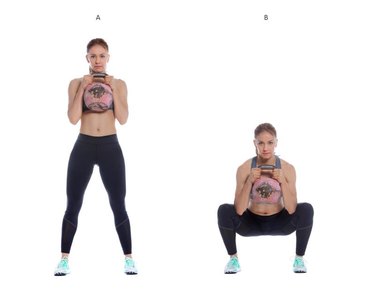
Combining exercise and diet is the only way to lose belly fat. If you're trying to lose belly fat, first, you need to make sure you have your diet under control — that means you can't slam back milkshakes, double cheeseburgers and potato chips. Instead, eating more lean protein, green leafy vegetables and heart-healthy whole grains will give you the energy you need to ramp up your metabolism with exercise over the next 30 days.
Exercise to Lose Fat
Video of the Day
Revving up your metabolism to burn belly fat in 30 days is going to require exercises that use multiple muscle groups at once. Full-body strength movements, such as push-ups, pull-ups, lunges, deadlifts, overhead shoulder presses, dumbbell bench press or goblet squats, use more than one set of muscles at once. The more muscles you use, the more calories you burn. With only 30 days to lose belly fat, the more calories you burn, the more fat you'll lose.
Read More: Full Body Strength Training Routine
Video of the Day
Goblet Squats

Goblet squats are a powerful exercise that targets your thighs, hamstrings, glutes and core.
Step 1
Hold a dumbbell at chest height with your hands under one end, like you are holding a goblet of liquid.
Step 2
Keep your forearms parallel to one another. Keep your feet at shoulder-width distance, maintaining weight through your heels.
Step 3
Descend into a squat position as if sitting in a chair, keeping your back straight and chest upright. From the bottom of the squat, push through your heels, standing up to the starting position.
Step 4
Perform 10 reps of squats for three sets.
Bent-Over Dumbbell Row
Rowing exercises target your back, arms and shoulders. Like the goblet squat, they require multiple muscle groups to work together, increasing the calories you burn.
Step 1
Grab two moderate weight dumbbells, positioning your palms so they are facing your body the entire time.
Step 2
Slightly bend your knees, pushing your butt back towards the wall. This will bring your chest forward as you bend at the waist. Make sure to maintain a straight back from this position. Let the dumbbells hang directly in front of you, keeping your arms perpendicular to the floor.
Step 3
Squeeze your abs and core to maintain a straight posture and pull the dumbbells to your side. Your elbows should stay close to your body. Once you reach the top position, squeeze the muscles of your back and slowly lower the weight back towards the floor.
Step 4
Perform three sets of 10 reps of dumbbell rows
Cardiovascular Training
The Centers for Disease Control and Prevention suggests that, for weight control, you should participate in moderate-intensity aerobic activities for 150 minutes a week, or 75 minutes of vigorous-intensity aerobic activities.
Moderate intensity means you notice you're breathing harder and your heart rate is faster, but you can still carry on a conversation. Brisk walking, playing with children, light yard work or a slow pace on a bike would be considered moderate-intensity.
Vigorous intensity means that your heart rate has increased significantly and, due to your breath quickening, can't carry on a conversation. Running, swimming laps, speed skating or jumping rope would be considered vigorous-intensity.
Interval Training
If slogging away on the treadmill sounds boring to you, interval training — alternating from high intensity to low intensity — increases your caloric expenditure. Interval sessions require you to work at a higher intensity versus steady state cardio; these interval sessions may only require 20-30 minutes.
Read More: High-Intensity Interval Training for Weight Loss
Walk Your Way Lean
If you're combining strength training and cardio but still find that one to two days a week you have no activities but want to remain active to keep the caloric burn going, there is no better way to burn fat and promote healthy recovery than by walking. According to The American Heart Association, walking provides the same benefits as running, such as decreasing your risk of heart disease, stroke and diabetes, improving your blood pressure, reducing your risk of osteoporosis and enhancing your mental well-being. The rule of thumb is around 100 calories are burned per mile of walking.

If the average walking pace is 4 miles an hour, you'll burn an extra 400 calories or more even on the days you're not in the gym. To add more steps to your daily total, try parking further away from where you work or shop, take the dog for an extra evening walk, schedule walking meetings or opt for the stairs instead of the elevator.
NEAT
There is one other neat way to increase calorie burn. It's what scientist call NEAT: non-exercise activity thermogenesis. These are the activities you do every day that doesn't involve dedicated time to exercise. Typing on the computer, cleaning your kitchen, emptying out the garage, yard work, gardening, even fidgeting are all examples of non-exercise ways that you move your body and burn calories. If you're trying to burn belly fat in a short period of time, take this opportunity to clean out the garage or attic, spend some time in the backyard or deep clean your home.